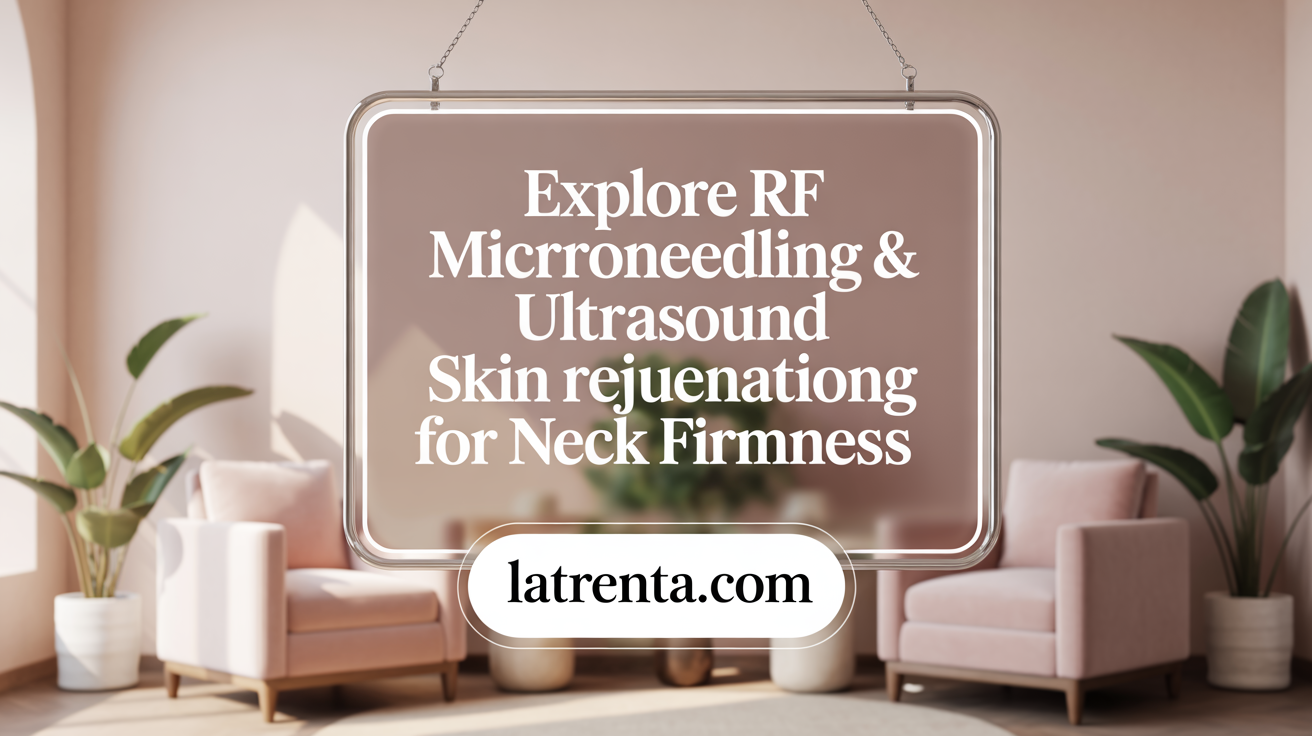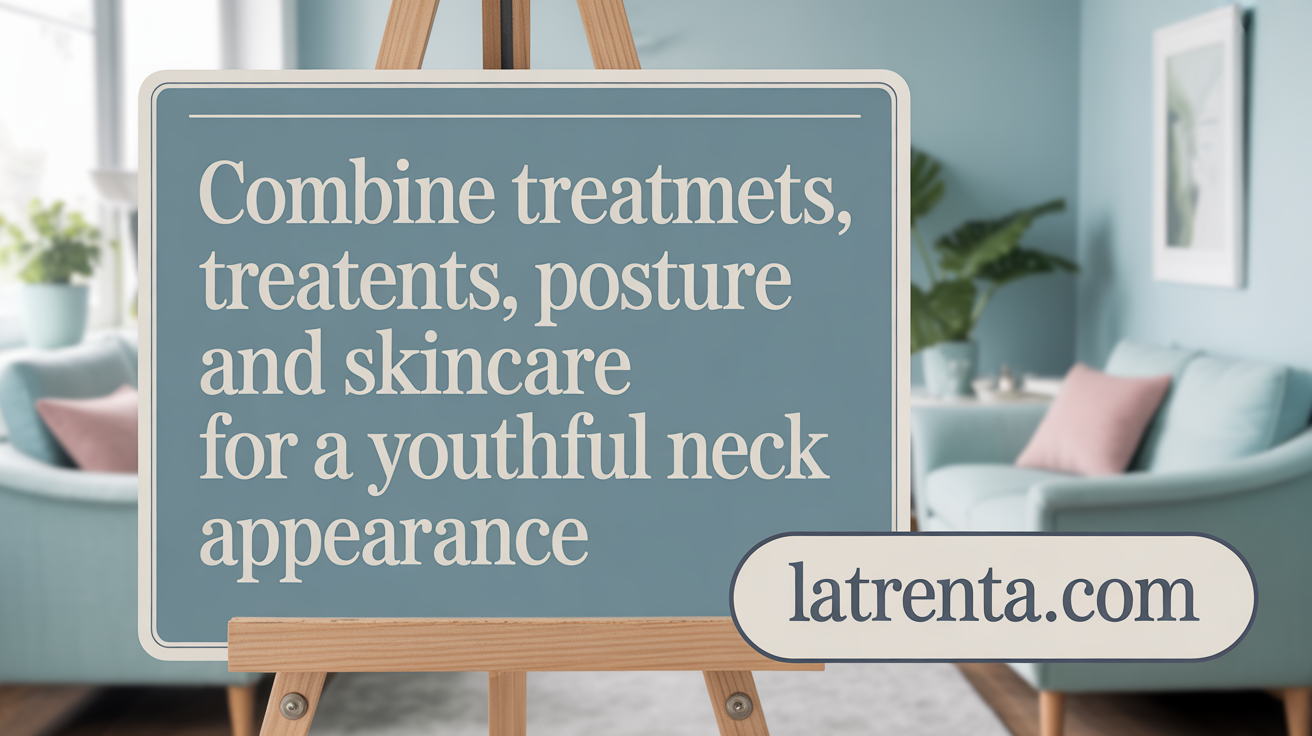Understanding Tech Neck and Its Aesthetic Impact
Tech neck has emerged as a common concern in our digital age, characterized by visible neck wrinkles and sagging skin caused by prolonged device use. This article explores the causes of tech neck, prevention strategies, and a range of aesthetic treatments that improve neck appearance without surgery. Readers will gain insights into modern non-invasive therapies, skincare recommendations, and posture corrections to effectively address tech neck and rejuvenate the neck's youthful look.
The Causes and Development of Tech Neck Wrinkles
What causes tech neck and neck wrinkles?
Tech neck and neck wrinkles are mainly the result of modern lifestyle habits, particularly the frequent use of handheld digital devices like smartphones and tablets. When people look down at their screens for extended periods, their neck muscles—especially the platysma—become overused and contracted repeatedly. This continuous flexing encourages the formation of horizontal lines across the neck, often called neck bands or wrinkles.
The skin on the neck is thinner and more delicate than the skin on other parts of the body. As a result, it is highly susceptible to structural changes caused by aging, sun damage, and lifestyle factors. Collagen and elastin, two proteins vital for skin elasticity and firmness, naturally decrease with age, leading to sagging and wrinkle development. Exposure to ultraviolet (UV) rays from the sun accelerates this process by breaking down these proteins further, which explains why the neck—often exposed to sunlight—shows signs of aging earlier.
Additionally, repetitive movements and poor posture during device use increase the strain on neck muscles and skin, promoting the development of creases and sagging. Blue light emitted by screens may also contribute to premature skin aging, further weakening the skin structure.
Lifestyle factors such as inadequate skincare, dehydration, smoking, and lack of sun protection worsen the condition. Poor posture, like tilting the head downward frequently, and habits like sleeping on the stomach with the neck twisted can also speed up wrinkle formation.
Preventative measures include maintaining good posture, using ergonomic devices, applying broad-spectrum sunscreens daily, and incorporating skincare with retinol and antioxidants. Non-invasive treatments such as Botox, microneedling, laser procedures, and radiofrequency skin tightening can effectively address existing conditions and improve skin quality.
In summary, tech neck and neck wrinkles are caused by a combination of mechanical strain from device use, aging-related collagen loss, sun exposure, and lifestyle influences that degrade skin structure over time. Addressing these factors through behavioral changes and professional treatments can help preserve a youthful neck appearance.
Preventative Measures and Posture Correction to Combat Tech Neck

How can posture correction contribute to preventing or improving tech neck?
Posture correction is essential in both preventing and alleviating tech neck. Proper alignment of the head, neck, and spine reduces the strain on neck muscles and ligaments, which are often overstressed during prolonged device use.
Setting up an ergonomic workspace helps maintain good posture. For example, positioning your phone or computer screen at eye level prevents the head from tilting forward, which is a primary cause of tech neck. Supporting your back with ergonomic chairs and using supportive cushions helps keep your spine aligned.
In addition to adjusting your workspace, incorporating exercises such as chin tucks, neck stretches, and shoulder retractions helps strengthen the muscles in the neck and upper back. These movements help counteract the negative effects of prolonged poor posture and reduce muscular fatigue.
Practicing good posture throughout the day, combined with taking regular breaks from screen time—ideally every 20 to 30 minutes—can prevent stiffness, muscle fatigue, and chronic pain associated with tech neck. These habits help maintain healthy muscle function and skin elasticity.
Overall, a consistent approach to posture correction, exercise, and ergonomic habits not only prevents the development of tech neck but also improves neck aesthetic by reducing sagging and lines caused by muscle strain and skin laxity.
Effective posture correction techniques and exercises
| Technique/Exercise | Purpose | How to Do It | Benefits |
|---|---|---|---|
| Chin Tucks | Strengthens neck muscles | Tuck chin inward, hold, and release | Reduces forward head posture |
| Neck Stretches | Loosens tight muscles | Gently tilt head side to side and front to back | Eases muscle tension |
| Shoulder Retractions | Improves upper back posture | Pull shoulders back and down | Enhances spinal alignment |
Role of frequent breaks from screens
Taking short breaks regularly prevents continuous muscle strain. Following the 20-20-20 rule—every 20 minutes, look at something 20 feet away for 20 seconds—helps relax eye and neck muscles.
Sun protection and skincare basics
Using broad-spectrum SPF 50+ sunscreen daily is vital in protecting the neck from UV damage, which accelerates skin aging and the formation of neck lines. Applying gentle cleansers, moisturizers, and topical retinol can further support healthy skin.
How posture improves neck aesthetics
Good posture minimizes the appearance of horizontal lines, sagging, and creases caused by muscle tension and skin laxity. It promotes a more lifted, youthful neck profile and maintains skin firmness through reduced overstretching of skin tissues.
Skincare Strategies and Topical Treatments for Neck Wrinkles
How do retinol, peptides, and hyaluronic acid contribute to improving neck skin?
Retinol, a derivative of vitamin A, promotes collagen production, which enhances skin firmness and reduces the appearance of wrinkles. Peptides support skin repair and boost collagen synthesis, leading to improved elasticity and smoothness. Hyaluronic acid is renowned for its ability to deeply hydrate the skin, plumping up fine lines and expanding volume where collagen loss has led to sagging.
What does recent research say about topical anti-aging treatments?
A recent study focused on a topical anti-aging neck treatment (TNT), tested on 35 healthy women aged 25 to 50. The results showed significant improvements in horizontal neck fold lines, elasticity, hydration, gloss, radiance, and overall skin tone after applying the TNT twice daily over 84 days. These improvements were backed by clinical photography and ultrasound data, confirming better skin quality. The treatment was well tolerated with no adverse reactions. It proved effective against signs of natural aging, including "tech neck" caused by digital device use.
Why is daily sunscreen essential for neck skin?
UV exposure accelerates skin aging by damaging collagen and elastin, leading to early wrinkle formation and sagging, especially in the delicate neck area. Regular application of broad-spectrum SPF 50+ sunscreen can significantly slow down the development of neck lines. Protecting the skin from sun damage is considered one of the most effective preventative measures.
How important are hydration and antioxidants in maintaining neck skin health?
Keeping the skin well-hydrated with topical moisturizers containing hyaluronic acid helps maintain elasticity and smoothness. Additionally, skincare ingredients like peptides, vitamin C serums, and antioxidants combat free radicals generated by blue light from screens and UV exposure. Together, they protect skin cells and promote collagen and elastin synthesis, essential for a youthful neck appearance.
| Skincare Strategy | Benefit | Supporting Detail |
|---|---|---|
| Retinol | Stimulates collagen production | Enhances skin firmness and reduces fine lines |
| Peptides | Supports skin repair and elasticity | Improves skin resilience |
| Hyaluronic Acid | Deep hydration and volume | Reduces appearance of fine lines |
| Daily Sunscreen | Protects against UV damage | Prevents early signs of aging |
| Antioxidants | Neutralize free radicals | Protect skin from blue light and UV |
By combining consistent use of effective topical treatments, diligent sun protection, and hydration, individuals can significantly improve and maintain the youthful quality of their neck skin, addressing concerns like neck wrinkles and "tech neck."
Non-Invasive Aesthetic Treatments: Overview and Benefits
What non-invasive aesthetic treatments are available for neck wrinkles?
Many modern treatments are available to improve the appearance of neck wrinkles without surgery. Ultrasound-based procedures like Ultherapy and Sofwave use focused ultrasound energy to heat deep skin layers, stimulating collagen production and resulting in firmer, tighter skin. These treatments often show visible improvements within two to three months, with effects lasting over a year.
Radiofrequency (RF) treatments, including Thermage, Exilis, and Morpheus8, use deep heat to encourage collagen growth. Morpheus8, in particular, combines microneedling with RF energy, providing skin rejuvenation and reducing laxity over three to six months. Laser options like ClearLift and fractional resurfacing target skin quality and fine lines with minimal downtime.
Injectable solutions also play a significant role. Botulinum toxins such as Botox or Dysport® relax the platysma muscles responsible for neck bands, leading to a smoother neck contour. Dermal fillers made from hyaluronic acid can hydrate the skin, fill in lines, and restore volume, contributing to a younger appearance. These treatments are quick, with effects often seen within a week, and generally involve little to no downtime.
Complementing these therapies are fat reduction treatments like Kybella, which target double chin fat to improve neck profile. Together, these non-invasive options offer comprehensive solutions to address the signs of aging in the neck area, providing noticeable results with minimal disruption to daily life.
Botox, Dysport®, and Neuromodulators: Targeting Muscle Bands
How Botox and Dysport® work on the platysma muscle
Botox and Dysport® are neuromodulators derived from botulinum toxin that work by temporarily relaxing the muscles in the neck. Specifically, they target the platysma muscle, which when overactive, can cause horizontal neck bands and vertical platysma lines to form. By injecting small doses into this muscle, these treatments help reduce muscle contractions, smoothing out folds and creases.
Reduction of vertical and horizontal neck bands
These treatments are particularly effective in reducing both vertical neck bands and horizontal lines. Over time, relaxing the platysma muscle diminishes the prominence of existing bands and prevents the formation of new ones. Patients often notice a more refined and youthful neck contour within weeks after the procedure.
Duration and safety of results
The results from Botox and Dysport® typically last around 3 to 4 months, making repeat treatments necessary to maintain the smooth appearance. These treatments have an excellent safety profile when administered by experienced professionals. Common side effects are minimal and may include mild swelling or bruising, which usually resolve quickly.
Combination with other therapies for enhanced outcomes
For best results, neuromodulator injections can be combined with other skin rejuvenation strategies. Collagen-stimulating treatments like Skinvive, RF microneedling, or ultrasound-based therapies such as Ultherapy can enhance skin texture and elasticity. Additionally, topical skincare with retinol, peptides, and sunscreen helps support the skin’s health and prolongs improvements. Combining these modalities offers a comprehensive approach, addressing muscle activity, skin quality, and overall neck aesthetics.
Summary: Treatments like Botox and Dysport® provide a quick, effective way to relax neck muscles, smoothing out bands and lines. When combined with collagen-enhancing procedures and good skincare practices, they can significantly improve the neck’s appearance and youthfulness while maintaining safety and minimal downtime.
Skinvive and Collagen-Boosting Injectables: Hydrating and Firming Effects

How do Skinvive and hyaluronic acid fillers work?
Skinvive is a specialized injectable treatment that boosts collagen production, deeply hydrating the skin while supporting its structure. It involves injecting small amounts of a unique formulation into the neck area, which promotes elasticity and firmness over time. Hyaluronic acid fillers, on the other hand, are used to add volume to areas with volume loss, such as horizontal neck lines. These fillers hydrate the skin, fill in creases, and stimulate natural collagen synthesis, which further improves skin quality.
What are the benefits of collagen and elastin stimulation?
Stimulating collagen and elastin is essential for restoring skin's youthful appearance. Collagen provides structural support, reducing sagging and improving skin texture. Elastin allows the skin to return to its original shape after stretching, maintaining firmness and elasticity. Treatments like Skinvive enhance the production of these proteins, leading to smoother, plumper, and more resilient skin. The results include diminished appearance of neck lines and a rejuvenated, healthier look.
What does the procedure involve and what is the recovery?
The injection process is minimally invasive, typically involving multiple small injections administered by a trained professional. Patients generally experience minimal discomfort and can resume daily activities shortly after treatment. Recovery usually involves little to no downtime, with some mild swelling or redness that resolves within a few hours or days. Results develop gradually over several weeks to months as collagen rebuilds, providing a natural and lasting improvement.
How do injectable treatments complement skin tightening methods?
Injectables like Skinvive and hyaluronic acid fillers are often used alongside skin tightening treatments such as ultrasound (Ultherapy) or radiofrequency therapies (RF microneedling, Venus Legacy). While skin tightening devices stimulate collagen deep within the skin to lift and tighten, injectables focus on improving surface volume and hydration. Together, these therapies enhance overall skin quality, address different signs of aging, and produce a comprehensive, youthful neck appearance.
Radiofrequency Microneedling and Ultrasound Technologies for Long-Term Neck Firming

What is RF microneedling and how does it help with neck rejuvenation?
Radiofrequency (RF) microneedling combines the mechanical action of microneedles with the heat energy of RF. The device creates tiny channels in the skin, stimulating the body's natural healing response. As the skin repairs these micro-injuries, it produces more collagen and elastin, essential proteins that maintain skin firmness and smoothness.
The RF energy penetrates into the deeper layers of the skin, enhancing the tightening effect. This treatment is minimally invasive, with little discomfort and minimal downtime. Patients often notice improvements in skin texture, elasticity, and diminished wrinkles over time.
How do ultrasound-based treatments like Ultherapy and Venus Legacy work?
Ultrasound treatments use focused ultrasound energy to heat deep tissues beneath the skin surface. Ultherapy, in particular, guides the energy precisely to the dermal layers responsible for skin laxity. This heat stimulates collagen formation, leading to skin tightening and lifting.
Venus Legacy combines pulsed monopolar radiofrequency with pulsed magnetic fields to deliver deep heating. It enhances collagen production while also reducing fat in targeted areas. Treatments usually last around 30-60 minutes and are painless for most patients.
What are the timeline and longevity of results?
Collagen stimulation treatments like RF microneedling and ultrasound devices typically show gradual improvements. You can expect noticeable results within 2 to 3 months post-treatment as new collagen is generated.
The durability of these results depends on various factors including age, skin condition, and post-treatment care. Generally, effects can last from 12 to 24 months. Maintenance sessions, usually every 6-12 months, help prolong the youthful, firm appearance of the neck.
What about patient experience and downtime?
Most non-invasive collagen-stimulating treatments are well tolerated, with minimal discomfort. Some patients experience mild redness or swelling immediately after the procedure, which usually resolves within a few hours to a couple of days.
Since these treatments require little to no downtime, patients can return to daily activities shortly after sessions. Combining RF microneedling with ultrasound therapies often yields the best outcomes, especially when aimed at addressing sagging, wrinkles, and skin laxity.
Which approach is best to treat saggy neck skin without surgery?
The best non-surgical approach to saggy neck skin involves targeted skin tightening treatments that boost collagen and elastin. Ultrasound-based procedures like Ultherapy® and devices like Venus Legacy are highly effective for moderate laxity, offering natural-looking, gradual lift.
For additional enhancement, RF microneedling can improve skin texture and firmness synergistically. Combining these treatments with good skincare—such as topical retinoids, sun protection, and maintaining a healthy lifestyle—will further support skin firmness. For more significant sagging, minimally invasive options or surgical procedures like neck lifts may ultimately be necessary.
Incorporating a personalized treatment plan based on a thorough assessment ensures the best outcomes, leveraging the regenerative capacity of your skin for long-lasting results.
Comprehensive Care: Integrating Treatments with Lifestyle and Skincare for Lasting Results

Why is it important to develop personalized treatment plans and seek professional advice?
A tailored approach is essential because each person’s skin, aging process, and lifestyle are unique. Consulting with a qualified aesthetic professional helps assess the specific signs of aging, such as neck lines, sagging, or muscle overactivity, and choose the most effective combination of treatments. Whether opting for neuromodulators like Dysport®, hyaluronic acid fillers, or energy-based devices, proper guidance ensures safe, targeted, and sustainable results.
How can combining aesthetic procedures with posture correction benefit overall neck health?
Poor posture, especially from prolonged device use, significantly contributes to 'tech neck' and neck wrinkles. Correcting posture through ergonomic adjustments, neck stretches, and strengthening exercises supports the effects of clinical treatments. For instance, relaxing the platysma muscle with Botox paired with posture correction can prevent recurrence of horizontal bands and improve skin tone. Physical habits, like taking regular breaks and ensuring proper device alignment, also minimize strain and complement medical rejuvenation.
What role do skincare routines play in supporting clinical treatments?
Skincare is fundamental in maintaining and enhancing treatment results. Daily use of broad-spectrum SPF 50+ on the neck shields against UV damage, which accelerates aging and wrinkles. Incorporating topical retinol stimulates collagen and improves skin texture. Peptide-containing moisturizers and vitamin C serums support skin elasticity and brightness. When combined with professional procedures, these products help sustain improvement, boost collagen synthesis, and protect against environmental aggressors.
What lifestyle habits support prevention and long-term maintenance?
Lifestyle choices are pivotal in protecting the neck from premature aging. Staying hydrated, eating a nutrient-rich diet, and avoiding excessive sun exposure contribute to healthier skin. Regular physical activities and neck exercises strengthen muscles and promote better posture. Limiting blue light exposure from screens, using blue light filters, and practicing stress reduction techniques further prevent accelerated skin aging. Combining these habits with a consistent skincare and treatment routine creates a comprehensive strategy, maximizing and prolonging aesthetic results.
Overview of treatment options and strategies in a summarized table:
| Treatment Type | Purpose | Typical Results Timeline | Length of Effectiveness |
|---|---|---|---|
| Neuromodulators (Botox, Dysport®) | Relax muscles, smooth lines | 1-2 weeks | 4-6 months, repeat as needed |
| Dermal Fillers (Hyaluronic Acid) | Hydrate, add volume, reduce wrinkles | Gradual over several weeks | 6-12 months or longer |
| Energy-Based Devices (Ultherapy, RF microneedling) | Collagen stimulation, skin tightening | 2-3 months | 1 year or more, depending on treatment |
| Thread Lifts & Collagen Stimulation | Lift and tighten skin | Immediate with gradual improvement | 9-12 months or longer |
| Surgical Options (Neck lift) | Correct severe sagging and laxity | Several weeks post-op | Several years depending on aging and post-care |
Can neck wrinkles be reversed?
Yes, it is possible to reverse or significantly improve neck wrinkles through a variety of treatments combined with lifestyle changes. Procedures like Botox relax overactive muscles, smoothing horizontal bands, while dermal fillers restore volume and hydration. Energy-based treatments stimulate collagen production, tightening loose skin, and reducing overall wrinkles. Consistent use of skin protection products, especially sunscreen and retinoids, enhances these effects. For more advanced aging signs, surgical options can provide long-lasting results. A comprehensive, personalized plan—crafted with professional guidance—can effectively restore youthful neck contours and skin quality.
Enhancing Neck Beauty: A Modern Aesthetic Perspective
Treating tech neck effectively requires a multifaceted approach that combines understanding its causes, practicing preventive measures, and utilizing advanced aesthetic treatments. From neuromodulators like Botox and Dysport to collagen-stimulating technologies such as Ultherapy and radiofrequency microneedling, non-invasive options offer impressive results with minimal downtime. Complementing these treatments with proper posture correction and diligent skincare routines maximizes outcomes and prolongs youthful neck appearance. With personalized care plans and the latest therapy combinations, embracing the aesthetic approach to tech neck can help restore confidence and natural elegance to the neck area without surgery.
References
- How to Treat Tech Neck: The Best Med Spa Solutions
- A Rejuvenating treatment targeting “tech neck” lines and wrinkles in ...
- Treating 'Tech Neck' Lines - Collins Cosmetic Clinic
- How to Get Rid of Tech Neck Wrinkles Without Surgery
- Is Your Phone Aging Your Neck? Understanding and Reversing ...
- Good Morning America Reports: Treating Tech Neck
- 5 Ways to Treat Tech Neck Wrinkles - Dr. Duplechain
- Tech Neck Lines Treatment in New York - Philip Miller MD
